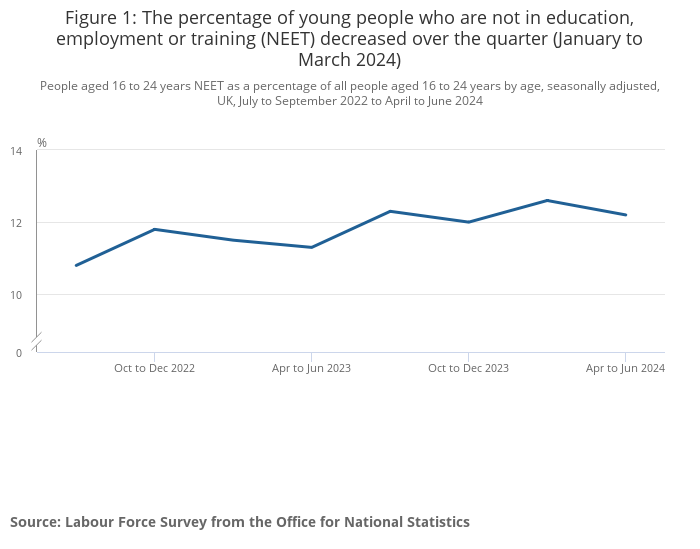ONS NEET data: 12.2% of all 16-24 year olds are NEET, April to June 2024 increase to 872,000.

On the day the GCSE Results and Level 1 and 2 VTQ qualifications were released, ONS released their latest data on the number of young people aged 16 to 24 years not in education, employment or training (NEET) in April to June 2024, with the total currently estimated to be 872,000, up from 798,000 in April to June 2023. . Interestingly the GCSE results (also released today) showed an increase in 17 year olds plus having to complete GCSE English and Maths.
There was an increase in the number of young people aged 16 to 24 years not in education, employment or training (NEET) in April to June 2024, with the total currently estimated to be 872,000, up from 798,000 in April to June 2023.
- The percentage of all young people who were NEET in April to June 2024 was estimated at 12.2%, up 0.9 percentage points on the year.
- The increase in the number of young people who were NEET was driven by young men, who saw an increase of 69,000 on the year to 493,000.
- The number of young people who were NEET and unemployed in April to June 2024 was estimated to be 332,000, a decrease of 1,000 on the year.
- There were an estimated 540,000 young people in the UK who were NEET and economically inactive, an increase on the year of 75,000.
An estimated 12.2% of all people aged 16 to 24 years in the UK were not in education, employment or training (NEET) in April to June 2024. This is up 0.9 percentage points compared with April to June 2023, and down 0.4 percentage points on the previous quarter.
Interestingly today is also GCSE Results day and VTQ Level 1 and 2 results day. Which revealed that for students aged 17 years and over there was an increase by 25.8% for GCSE English language and by 20% for GCSE Maths.
Increase in young men who are NEET
An estimated 13.5% of young men (up 1.7 percentage points on the year) and 10.8% of young women (largely unchanged on the year) were NEET. There were 872,000 young people who were NEET in total, an increase of 74,000 on the year. This increase was driven by young men. Of the total number of young people who were NEET, 493,000 were young men and 379,000 were young women.
The total number of people aged 18 to 24 years who were NEET was 807,000, up 65,000 on the previous year.
The percentage of those aged 18 to 24 years who were NEET was 14.5%, which was up 1.1 percentage points on the year, and down 0.4 percentage points on the quarter.

Unemployed young people who were not in education, employment or training
There were an estimated 332,000 NEET young people aged 16 to 24 years who were unemployed in April to June 2024, down 1,000 from April to June 2023 and up 13,000 from January to March 2024. An estimated 213,000 of these unemployed NEETS were young men, and 120,000 were young women. The number of NEET men aged 16 to 24 years who were unemployed decreased by 24,000 on the year from April to June 2023, while the number of NEET women aged 16 to 24 years who were unemployed increased by 23,000 on the year.
Economically inactive young people who were not in education, employment or training
In April to June 2024, there were an estimated 540,000 economically inactive young people aged 16 to 24 years who were NEET. This was up 75,000 on the year from April to June 2023, and down 40,000 on the quarter from January to March 2024. The number of young men who were NEET and economically inactive was 280,000 and the corresponding number of young women was 260,000. The total increase of 75,000 on the year was driven by young men, who saw an increase of 93,000 on the year from April to June 2023, while young women aged 16 to 24 years who were NEET and economically inactive decreased by 18,000 on the year.
Sector Reaction to the latest ONS NEET data:
TUC General Secretary Paul Nowak said:
“Every young person needs a good start to their working life, to set them on a path of opportunity and security.
“But over the last few years the number of young people not earning or learning continued to increase. And today’s figures are another damning indictment of the Conservatives’ failure to secure young workers’ prospects.
“The Labour government has already recognised the need for change, promising a youth guarantee to help young people into work, training or an apprenticeship.
“As plans are developed, it will be vital that young people are better able to access genuine opportunities that can help them get the best possible start in their careers.”
Patrick Thomson, Head of Research and Analysis at Phoenix Insights commented:
“To achieve economic prosperity it’s critical that we confront the challenges faced in ensuring both young, and older workers, are able to secure fulfilling and meaningful employment.
“Our research has shown that those aged 16-24 have an employment rate of just over 50%, around 30% behind the employment rate for those 25-49, while those aged 50-64 have an employment rate of over 70%. This morning’s data release found that the number of young people aged 16-24 years not in education, employment or training (NEET) has increased to 872,000, up from 798,000 this time last year.
“While part of this gap for younger generations is due to many staying in education to build their skills, this latest data set from the ONS highlights how the age employment gap is partly the result of the large portion of young people that are neither in work, training, or education.
“Reducing the size of this group is an essential step in boosting employment across the UK, moving us towards an 80% employment rate and in matching leading members of the G7. It will also have enormous economic and social benefits in terms of national productivity as well as for people’s ability to earn and save for their futures.
“To achieve this means tackling the challenges faced by those at each end of the labour market. For younger workers this means ensuring that training, education and first jobs give people what they need to embark on working lives that might last multiple decades, which the proposed Youth Guarantee focuses on, we also need to unlock the potential of all ages to ensure nobody faces barriers entering and remaining in the workplace.”
Simon Ashworth, AELP Deputy CEO and Director of Policy:
“An increase in the number of young people not in education, employment or training to 872,000 should be of deep concern to us all. Without signification intervention we risk a crisis that will have profoundly negative wider impact on individuals, society and the economy for years to come.
AELP members who play a huge role in delivering programmes for people in this age group – and we know from their work that there is a clear need for a pre apprenticeship programme to bring young people closer to the world of work.
Incentives for employers, alongside a funding premium for providers helping to support those not already in education, employment or training, would ensure young people are given the opportunity to work and/or learn. As well as this, a better alignment between T Levels and apprenticeships to support progression would go a long way to tackle this issue – as would recognising prior learning as a benefit not a barrier.”
Rosalind Gill, Head of Policy and Engagement at the National Centre for Universities and Business (NCUB) said:
“New figures released today reveal a worryingly high economic inactivity rate. The number of people aged between 16-24 years rose significantly by 12.2% over the last year. This highlights the urgent need for a comprehensive government strategy to support young people in their transition from education to employment.”
Gill concluded: “As technology advances, the labour market is rapidly evolving, and this will make skill gaps increasingly severe. If we don’t address this now, these gaps and rising unemployment could reach critical levels, jeopardising our nation’s economic growth and resilience. Without immediate action, and a cohesive plan from the Government, we risk further exacerbating youth unemployment and economic inactivity.”











Responses